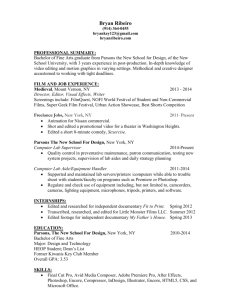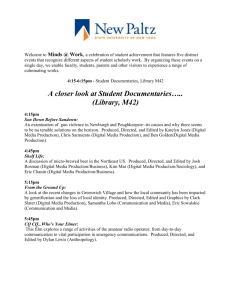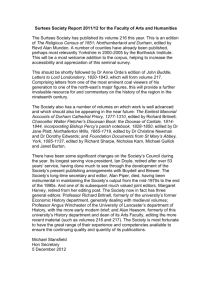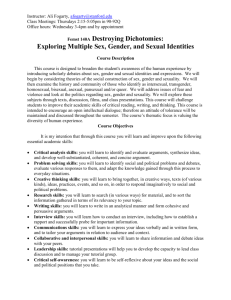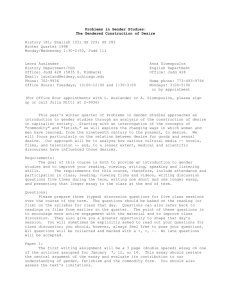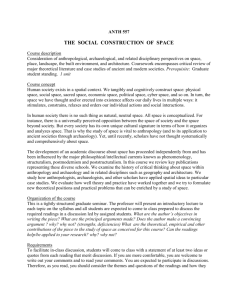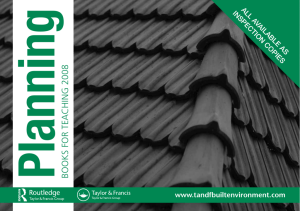Design and Technology - Edge Hill University
advertisement
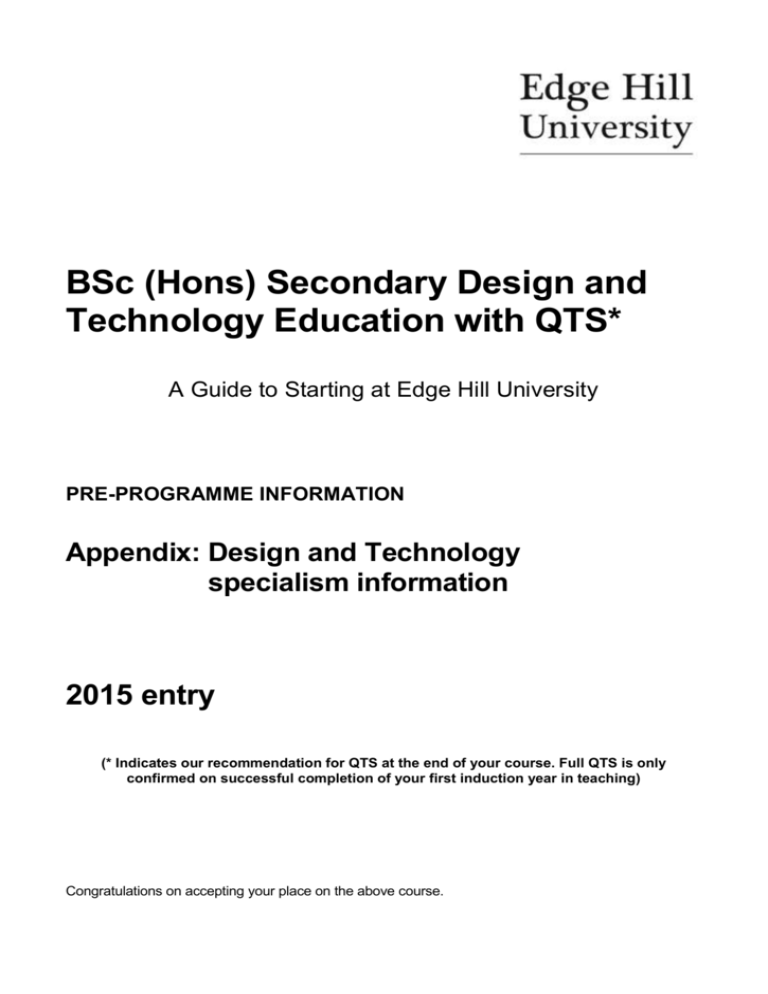
BSc (Hons) Secondary Design and Technology Education with QTS* A Guide to Starting at Edge Hill University PRE-PROGRAMME INFORMATION Appendix: Design and Technology specialism information 2015 entry (* Indicates our recommendation for QTS at the end of your course. Full QTS is only confirmed on successful completion of your first induction year in teaching) Congratulations on accepting your place on the above course. Individual course preparation The following pre-programme reading list will give you a very basic overview of the development of this subject area. It is not intended that these titles should be read from cover to cover as a novel would be, rather use them to dip into to gain a flavour of the work required. You may find it helpful to acquire these books from your local library (on extended loan, if possible) before term commences. It is not a requirement to purchase the books listed. However, having your own copy will prove helpful as the course progresses These are available through the Edge Hill University Library for you to load once you have fully enrolled as a student here at Edge Hill. Edited by: Owen Jackson, G (2008) Learning to Teach Design and Technology in the Secondary School: A Companion to School Experience (Learning to Teach in the Secondary School) (Learning to Teach in the Secondary School Series) Routledge Teaching Guide Edited by: Owen Jackson, G (2007) A Practical Guide to Teaching Design and Technology in the Secondary School Routledge Teaching Guide Davies, L., (2006) Meeting the Needs of Your Most Able Pupils: Design and Technology (Gifted and Talented) Longman Urry,S,et al. (2000) Advanced Design and Technology Longman There are, however, two texts that it is recommended that you read thoroughly before commencing the course. These two texts cover recent debates around the pertinent issues relating to the subject of Design and Technology. Both are edited texts and contain contributions from some of the leading experts, researchers and authors in the field of Design and Technology education. Edited by: Barlex, D., (2007) Edited by: Owen Jackson, G., (2013) Design and Technology for the Next Generation: A Collection of Provocative Pieces, Written by Experts in Their Field to Stimulate Reflection and Curriculum Innovation Debates in Design and Technology Education (The Debates in Subject Teaching Series) Cliffe & Co (Advertising & Marketing) Ltd Routledge Current issues in Design and Technology are the subject of many articles in journals. Most prominent of these is “Design and Technology Teaching” (The Journal of the Design and Technology Association - DATA). Design and Technology Teaching can be obtained by subscription or by student membership of DATA. There is no requirement to join this association, but its journal will provide you with valuable and topical information on the subject. Application forms for DATA can be obtained at the start of the course or downloaded from: http://www.data.org.uk/membership During the subject application element of the degree use will be made of research material and articles from newspapers such as the Times Educational Supplement, The Times, The Guardian and The Daily Telegraph. You would be advised to start developing your own file of newspaper and research articles relevant to the secondary school teaching, and in particular to design and technology. You can also begin to enhance your professional profile in the areas listed below – Research the National Curriculum at Key Stages 3 and 4. The current National Curriculum can be found here: https://www.gov.uk/government/publications/national-curriculum-in-england-designand-technology-programmes-of-study Research GCSE, AS and A2 level syllabuses for design technology (see examination board Websites such as www.aqa.org.uk). Enhance your ICT skills, to develop confidence in using word processing, databases, spreadsheets, internet search engines and other commonly used packages. The programmes normally used are Microsoft Word, Excel and PowerPoint. Look at the document which underpins all of the work which you will do on the course: Professional Standards framework January 2012. https://www.education.gov.uk/publications/standard/SchoolsSO/Page1/DFE-000662011 Continue to enhance your skills and subject knowledge in all areas (theoretical and practical) of Design and Technology. Gain observation experience in secondary school design and technology departments if you have not already done so. Personal tools and equipment It will be necessary for course members to purchase a quantity of equipment for their personal use on the course - especially in graphics, modelling and electronics. Tutoring staff will advise on this at the beginning of the course. However, the following items are necessary for the start of the course; Good British Standard Safety spectacles or goggles A workshop coat – usually white (also to be used on teaching practice) A selection of pencils for drawing (grades 2B, B, HB, 2H) and fine line pens (not steel tipped technical pens) Scissors, craft knife, safety rule, eraser and scalpel A pen drive / flash drive (2GB or larger is recommended) A good quality digital camera would also be very useful, although not essential, during the course as a recording tool – although many students choose to use camera phones for this purpose and they are ideal. Likewise, many students make use of personal laptops and tablet computers (iPads etc..) within the department and whilst studying on the course. Photographs In addition to the photographs that you may have been asked to supply will you please bring three passport size photographs with your full name on the reverse? These photographs are required by the course team and a copy will be circulated to staff to help them get to know course members by name as soon as possible. As qualified Design and Technology teachers you will be required to teach in at least two areas of the subject selected from: 1. 2. 3. 4. Resistant Materials Systems and Control Textiles Technology Food Technology Although Graphic Products is taught as a discrete subject within the KS4 curriculum, it is anticipated that teachers working within the four core elements of the subject will be able to teach graphic products as an integral part of their subject specialism up to at KS3 at least. At the start of the course you will be asked to complete a personal profile which records your expertise in these areas so it would be useful if you could reflect upon your previous experiences in readiness for this activity. We would like to remind you that as this is a teacher training course attendance on all organised sessions is a requirement. Pre-course Assignment The pre-course assignment is designed to get you thinking about the subject in the context of a secondary school setting. It is in two parts: Part 1: Research. The National Curriculum has undergone many changes over the past few decades; most recently in September 2013 and prior to this in 2008. Prior to this, there have been major changes in the education system and education policy which have shaped it into the subject it is now. From its roots in needle work, cooking, wood work, metal work and technical drawing it has evolved into a subject covering catering, resistant materials, product design and textiles technology, to name but a few. It utilises “smart materials”, biomimicry, advanced manufacturing processes (including laser cutting and rapid prototyping), e-portfolios in the assessment of coursework and many other technologically advanced processes and techniques. You are required to undertake some research into the origins of the subject and how it has developed? Why has it changed? What has been the impact of the National Curriculum? The Key Stage 3 strategy and the decision to make the study of a design and technology subject at KS4 optional? You should produce an A3 Poster showing the journey of Design and Technology as a subject and highlighting the salient points along the way. You need to print this poster out and bring it, hard copy, with you to the subject specific sections in induction week – it will be displayed in the department and used in one of your subject sessions. Part 2: Presentation. You are required to prepare a 4 to 5 minute presentation on your favourite designer, this is something which you will be delivering to your peer group at an appropriate opportunity, you will receive feedback on it and you should ensure that you do not exceed 5 minutes. (As a starting point; Consider why they are influential in your opinion? what work of theirs has inspired you? Are they unique in your opinion – why?) Communication: If you have any questions please feel free to contact me: David Wooff, (Course Leader, Senior Lecturer and SOLSTICE Fellow) Email: Tel: Twitter: wooffd@edgehill.ac.uk 01695 657183 @DesTech2013




